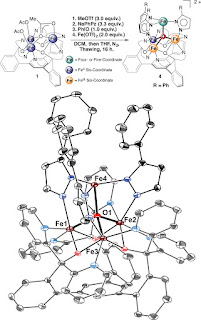Journal of the American Chemical Society
by Graham de Ruiter, Niklas B. Thompson, Davide Lionetti and Theodor Agapie
/
3d
// keep unread
// hide
// preview
http://pubs.acs.org/doi/10.1021/jacs.5b07397
http://pubs.acs.org/doi/pdf/10.1021/jacs.5b07397
A series of tetranuclear iron complexes displaying a site-differentiated metal center was synthesized. Three of the metal centers are coordinated to our previously reported ligand, based on a 1,3,5-triarylbenzene motif with nitrogen and oxygen donors. The fourth (apical) iron center is coordinatively unsaturated and appended to the trinuclear core through three bridging pyrazolates and an interstitial μ4-oxide moiety. Electrochemical studies of complex [LFe3(PhPz)3OFe][OTf]2 revealed three reversible redox events assigned to the FeII4/FeII3FeIII (−1.733 V), FeII3FeIII/FeII2FeIII2 (−0.727 V), and FeII2FeIII2/FeIIFeIII3 (0.018 V) redox couples. Combined Mössbauer and crystallographic studies indicate that the change in oxidation state is exclusively localized at the triiron core, without changing the oxidation state of the apical metal center. This phenomenon is assigned to differences in the coordination environment of the two metal sites and provides a strategy for storing electron and hole equivalents without affecting the oxidation state of the coordinatively unsaturated metal. The presence of a ligand-binding site allowed the effect of redox modulation on nitric oxide activation by an FeII metal center to be studied. Treatment of the clusters with nitric oxide resulted in binding of NO to the apical iron center, generating a {FeNO}7 moiety. As with the NO-free precursors, the three reversible redox events are localized at the iron centers distal from the NO ligand. Altering the redox state of the triiron core resulted in significant change in the NO stretching frequency, by as much as 100 cm–1. The increased activation of NO is attributed to structural changes within the clusters, in particular, those related to the interaction of the metal centers with the interstitial atom. The differences in NO activation were further shown to lead to differential reactivity, with NO disproportionation and N2O formation performed by the more electron-rich cluster.
http://pubs.acs.org/doi/10.1021/jacs.5b07397
http://pubs.acs.org/doi/pdf/10.1021/jacs.5b07397
A series of tetranuclear iron complexes displaying a site-differentiated metal center was synthesized. Three of the metal centers are coordinated to our previously reported ligand, based on a 1,3,5-triarylbenzene motif with nitrogen and oxygen donors. The fourth (apical) iron center is coordinatively unsaturated and appended to the trinuclear core through three bridging pyrazolates and an interstitial μ4-oxide moiety. Electrochemical studies of complex [LFe3(PhPz)3OFe][OTf]2 revealed three reversible redox events assigned to the FeII4/FeII3FeIII (−1.733 V), FeII3FeIII/FeII2FeIII2 (−0.727 V), and FeII2FeIII2/FeIIFeIII3 (0.018 V) redox couples. Combined Mössbauer and crystallographic studies indicate that the change in oxidation state is exclusively localized at the triiron core, without changing the oxidation state of the apical metal center. This phenomenon is assigned to differences in the coordination environment of the two metal sites and provides a strategy for storing electron and hole equivalents without affecting the oxidation state of the coordinatively unsaturated metal. The presence of a ligand-binding site allowed the effect of redox modulation on nitric oxide activation by an FeII metal center to be studied. Treatment of the clusters with nitric oxide resulted in binding of NO to the apical iron center, generating a {FeNO}7 moiety. As with the NO-free precursors, the three reversible redox events are localized at the iron centers distal from the NO ligand. Altering the redox state of the triiron core resulted in significant change in the NO stretching frequency, by as much as 100 cm–1. The increased activation of NO is attributed to structural changes within the clusters, in particular, those related to the interaction of the metal centers with the interstitial atom. The differences in NO activation were further shown to lead to differential reactivity, with NO disproportionation and N2O formation performed by the more electron-rich cluster.
Journal of the American Chemical Society
DOI: 10.1021/jacs.5b07397







コメント